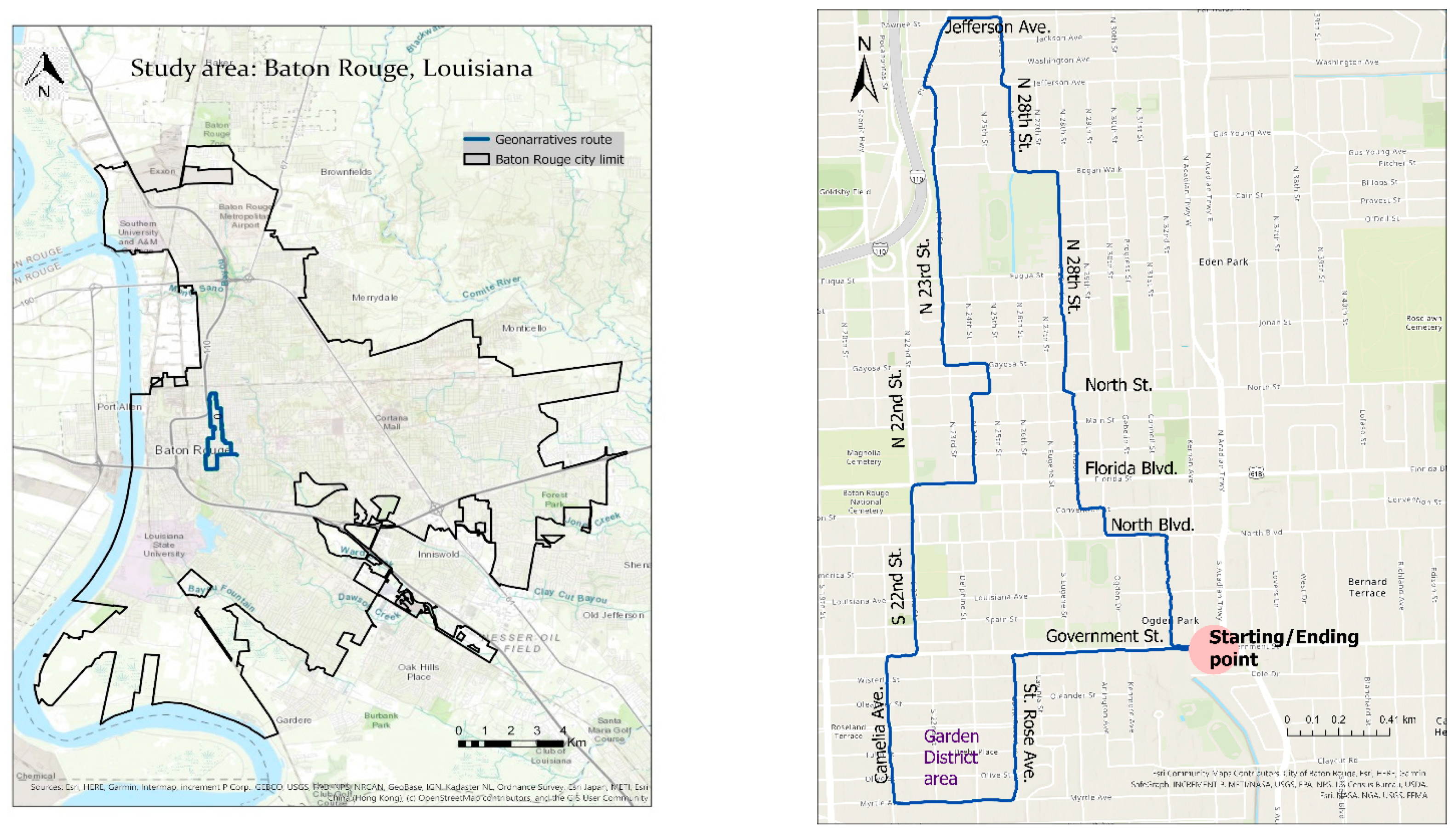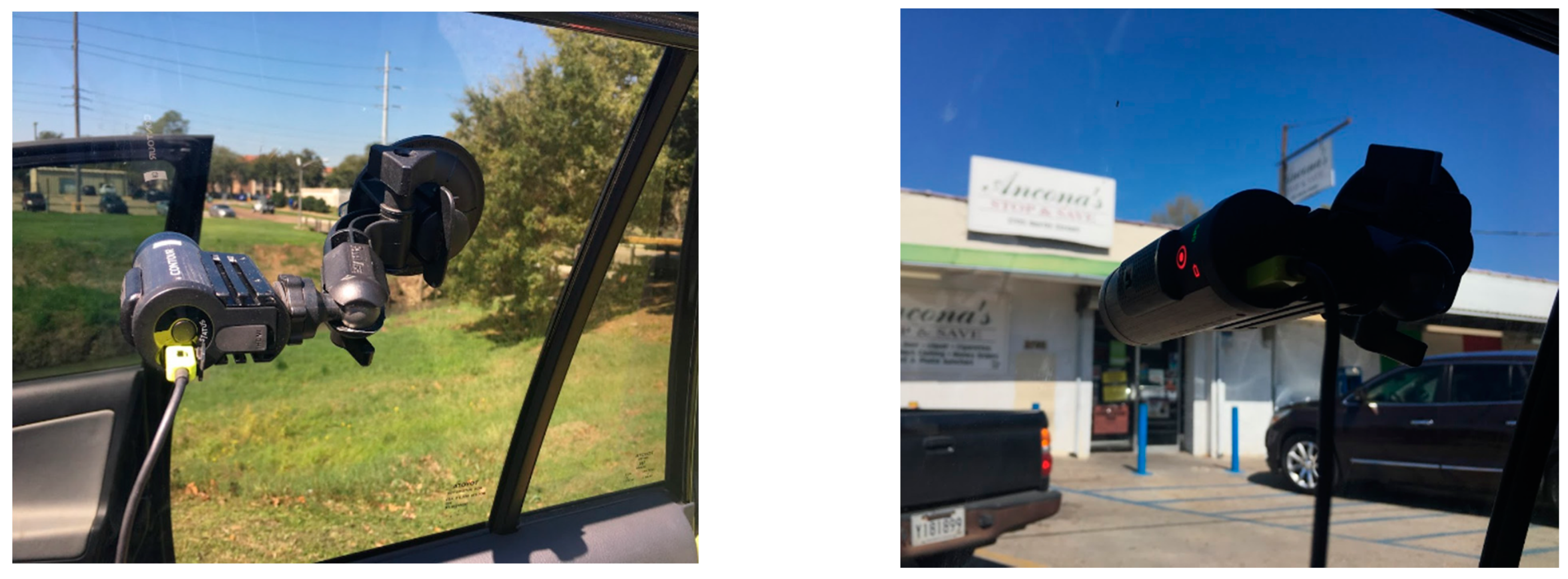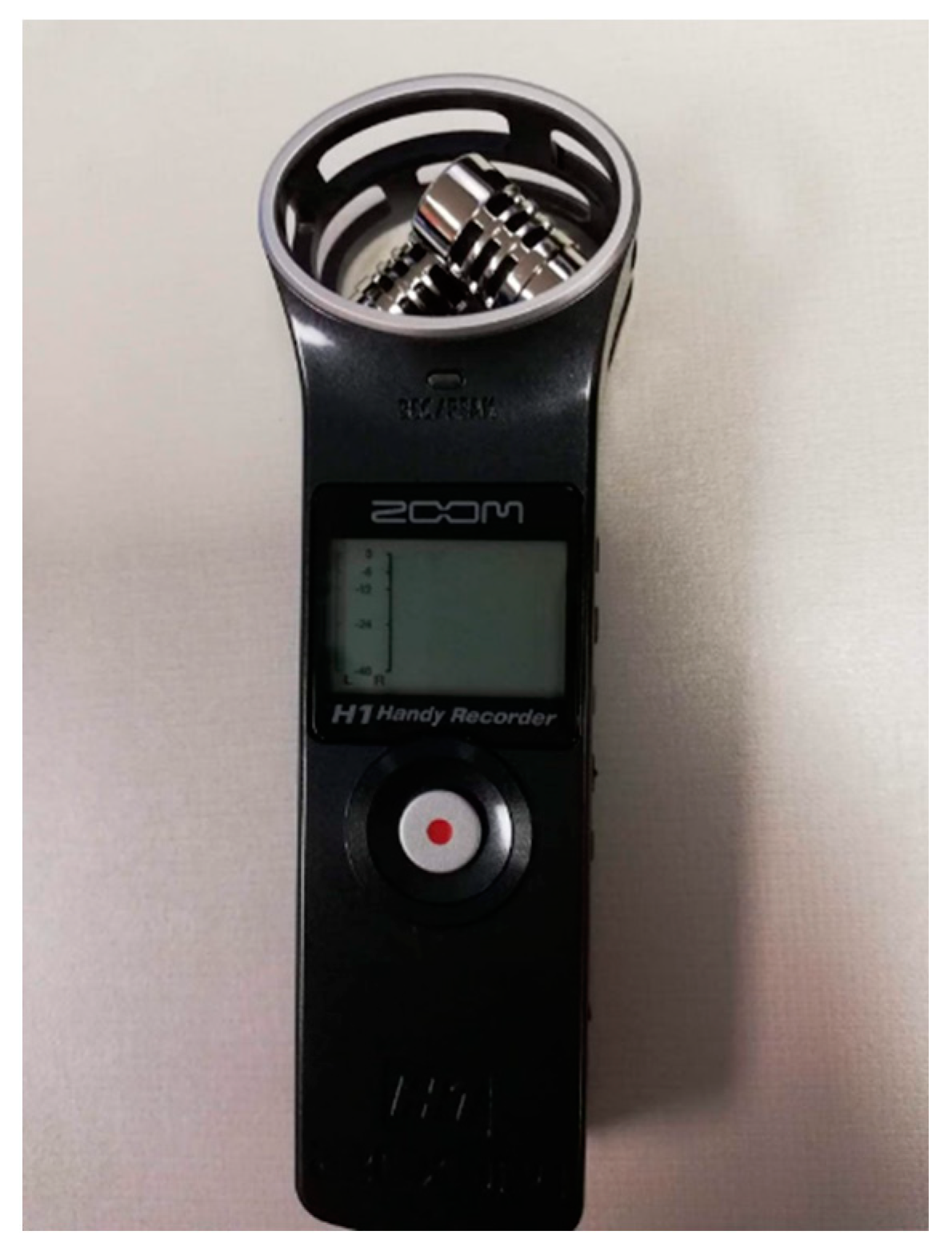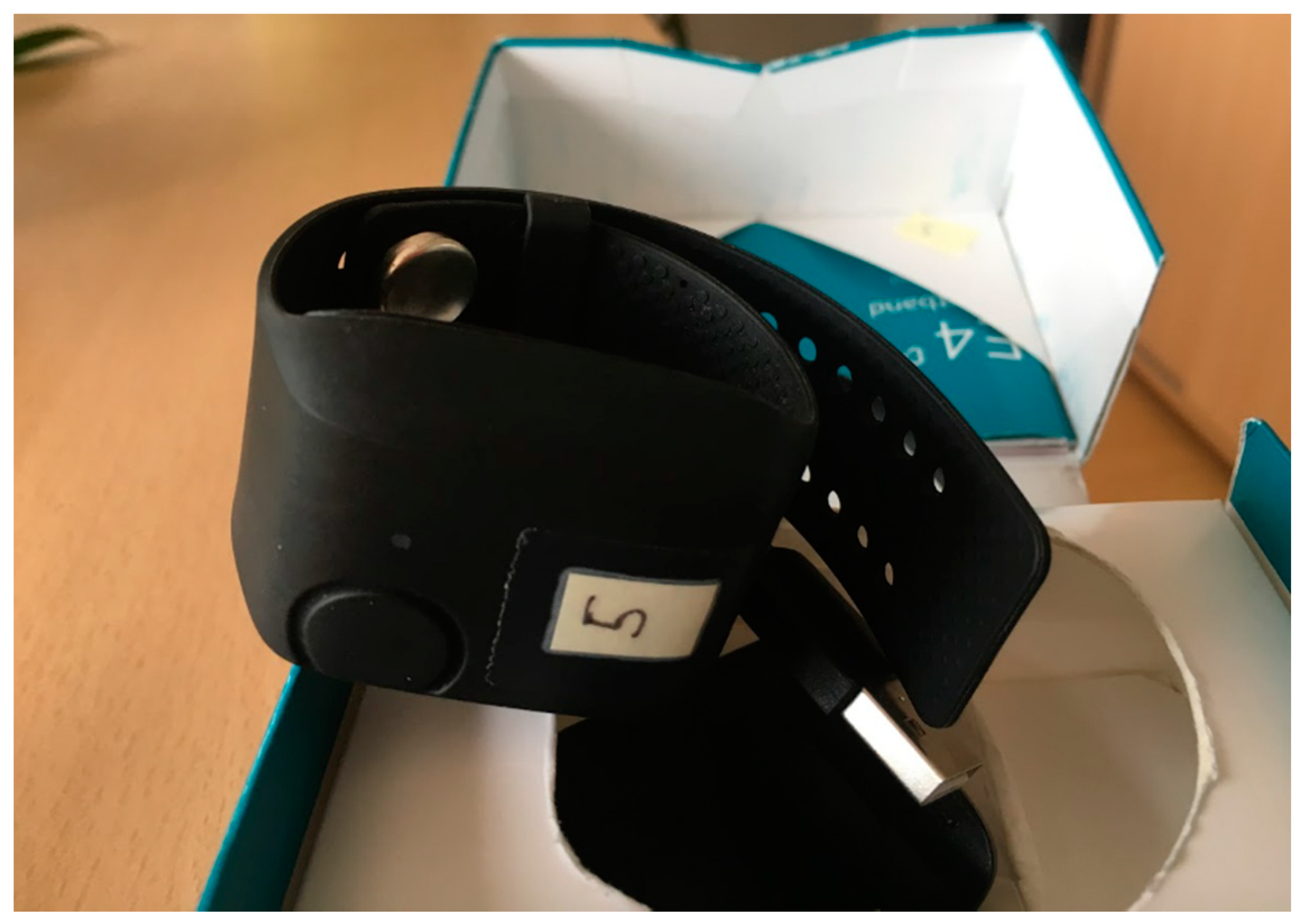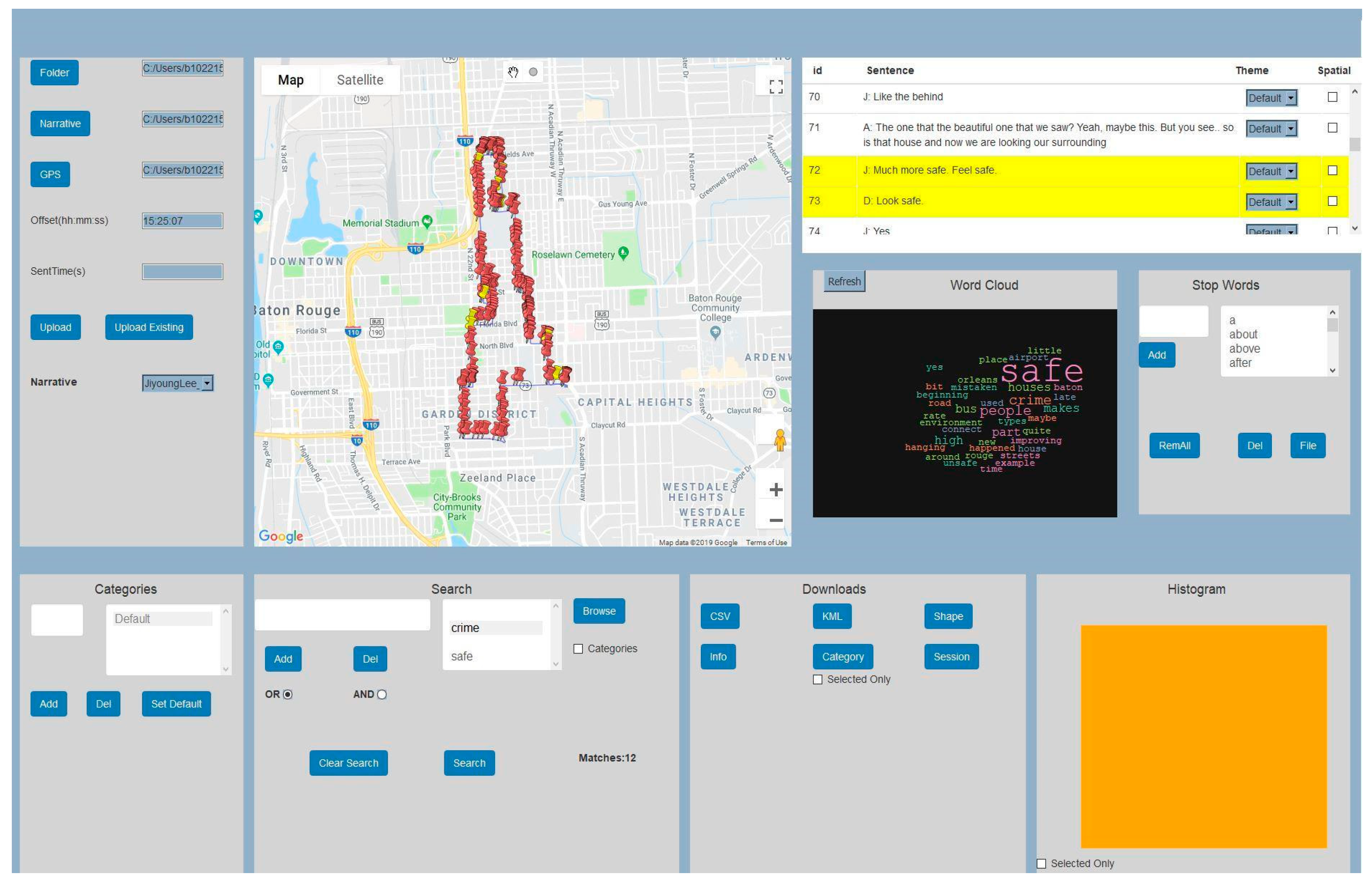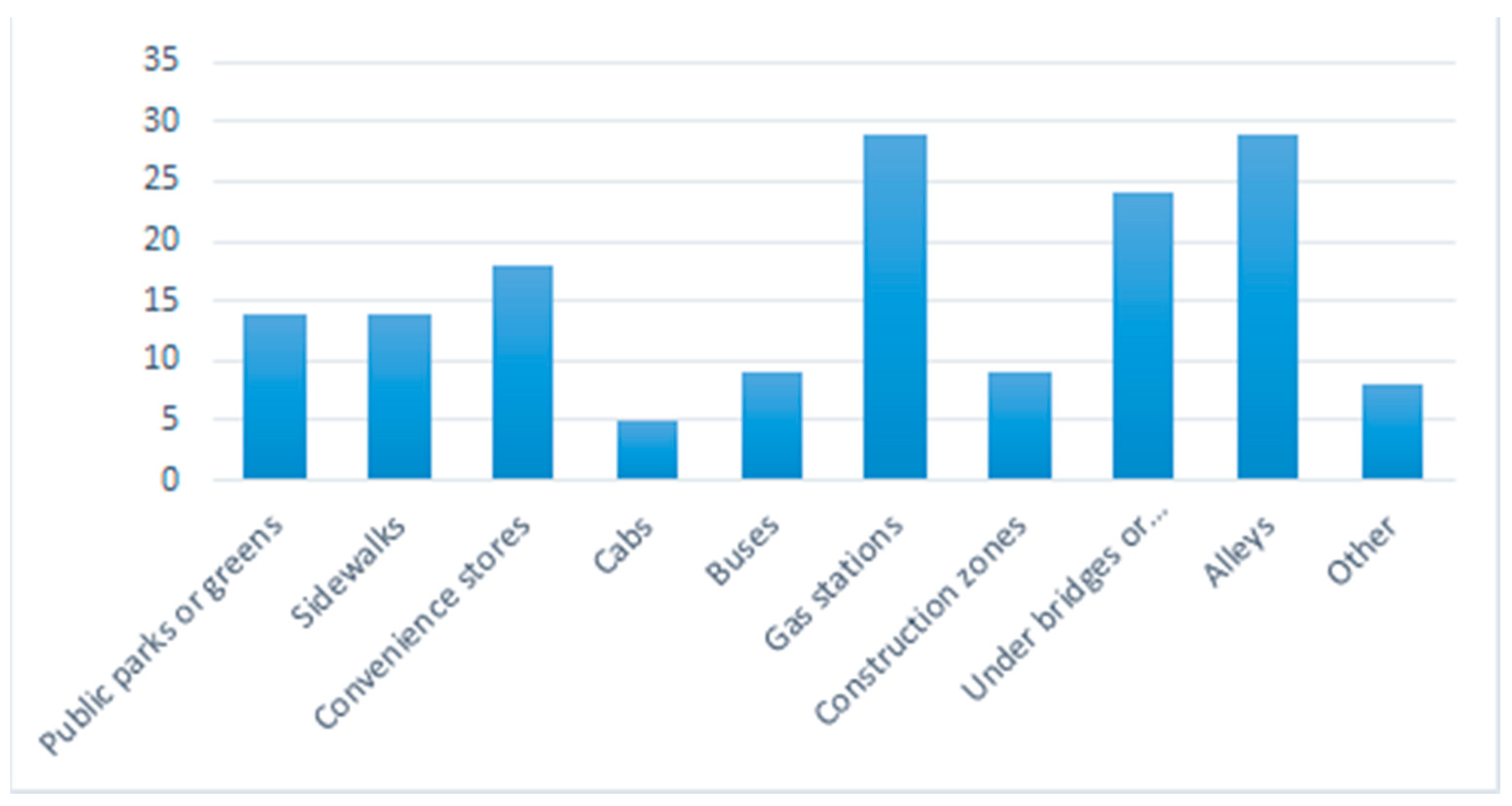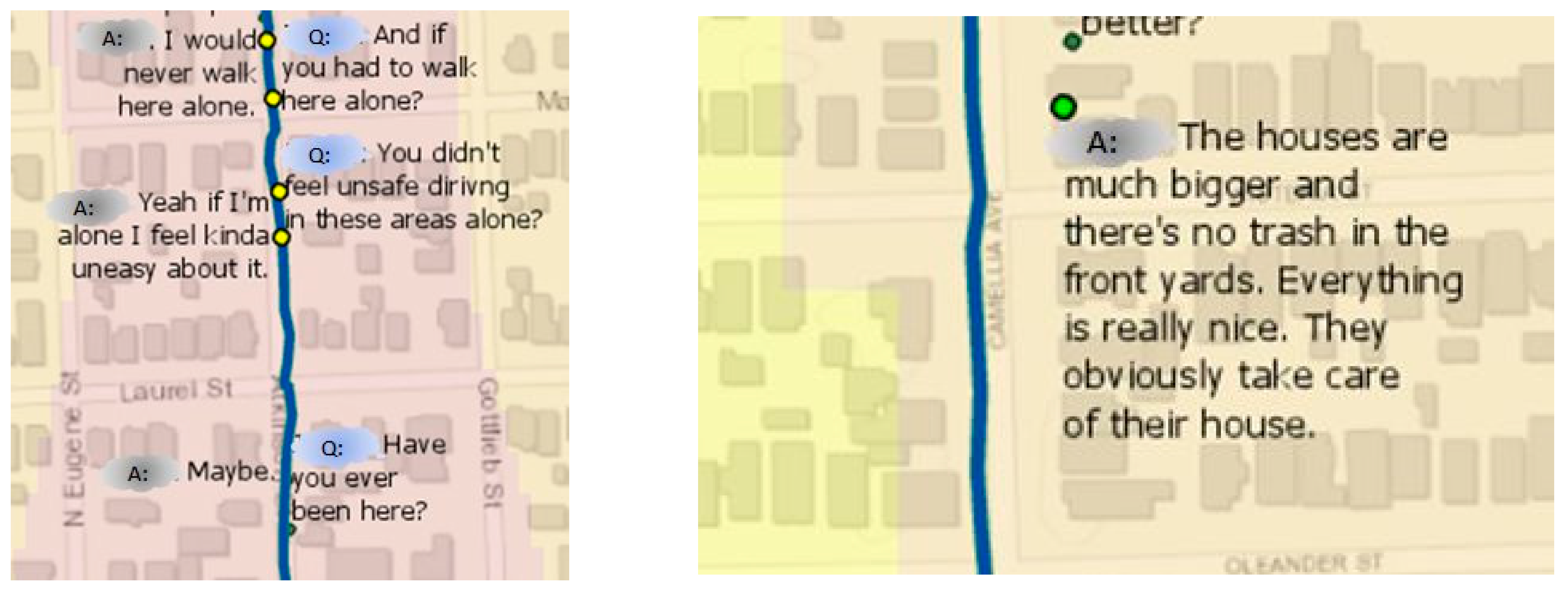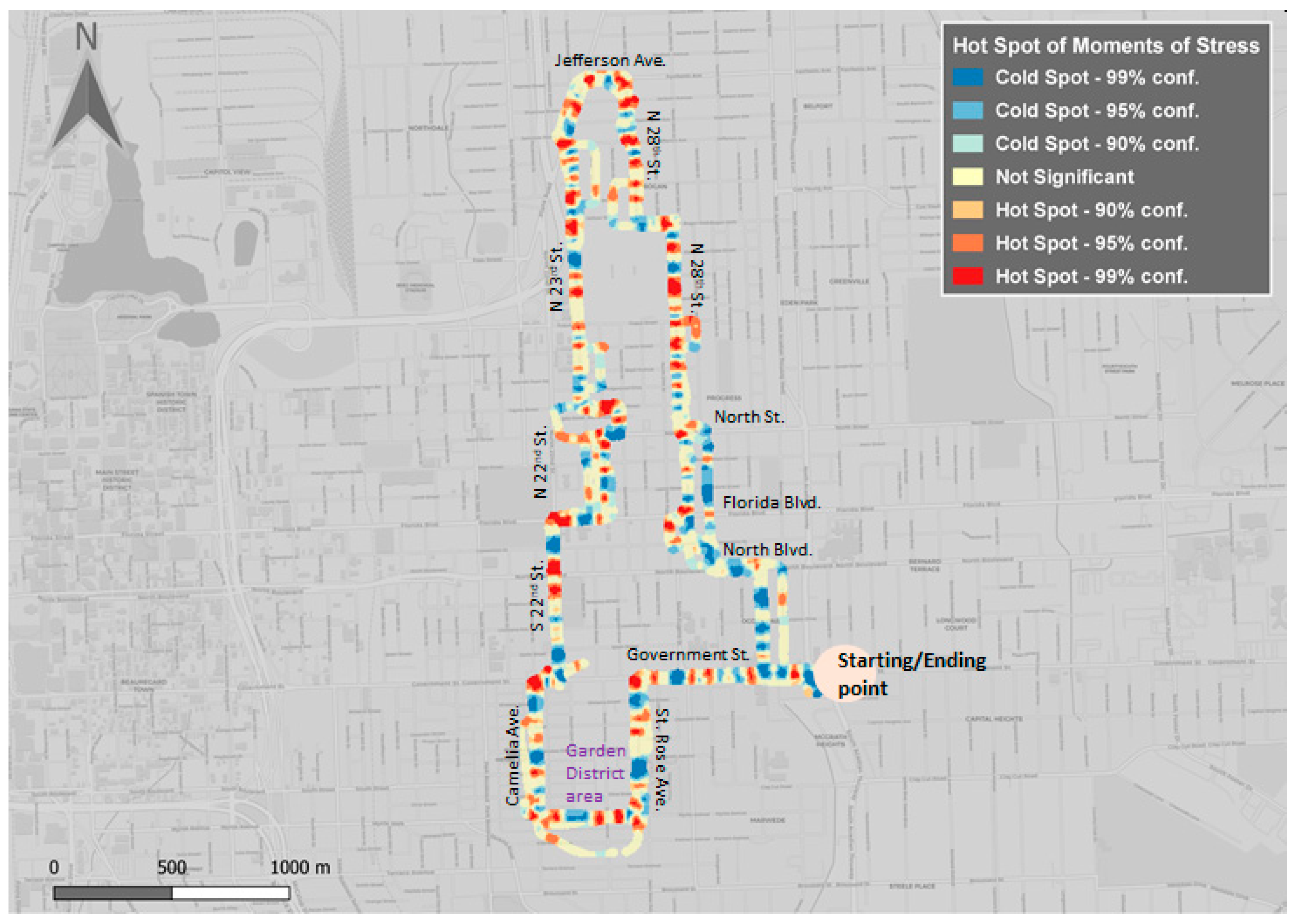1. Introduction
Research has consistently indicated that actual crime occurrences and the perceived fear of crime in urban areas are key concerns for society and that safety is highly important for a sustainable environment [
1]. At the same time, it has been discovered that fear of crime tends to occur at higher rates than reported crime occurrences [
2,
3]. One study showed that the perception of safety in a campus environment correlated with objective crime reporting, which is debatable at a larger city scale [
4]. An element that can be influential for crime perception is urban blight or urban decay. Urban blight refers to the phenomenon when a part of a city becomes deteriorated due to neglect for various reasons, mainly related to socio-economic conditions. Signs of blight are abandoned buildings or desolate areas, which are highly visible only at the micro-scale.
The application of geospatial technologies in researching spatial crime patterns started in the USA in the second half of the 1980s [
5]. During the same period, the safety of urban neighborhoods became the focus of many studies. Jacobs and Newman were pioneers in the study of urban planning concerning issues of safety [
6,
7], contributing to the creation of a new sub-discipline in criminology called Crime Prevention Through Environmental Design (CPTED) [
8]. CPTED is based on an agenda considering the proper design of the built environment and the effective use of buildings and public spaces in neighborhoods for diminishing fear and incidence of crime. Overall, CPTED methodologies lead to an improvement in the quality of life for citizens. Many researchers are contributing to the development of CPTED from various fields such as psychology, geography, and criminology. For example, Ref. [
9] encouraged environmental criminology with the theory of crime patterns, including crime attractors, generators, and detractors, which influenced discussions of various attractors for safety–crime perception. The Broken Windows Theory [
10] is another contribution stating that visible signs of public disorder, and anti-social behavior, create an urban environment more prone to crime. Since the 1970s researchers and practitioners started incorporating the social aspect in the CPTED, which was considered limited to the built environment.
One interdisciplinary research path includes the use of individual data nested in neighborhoods or similar clusters through hierarchical modeling, to examine connections between the built environment, social elements, and perceived crime [
11,
12,
13,
14]. These analyses are generally done by using social observation surveys. Ref. [
15] used a multilevel analysis in the city of Chicago to analyze collective efficacy, defined as social cohesion among neighbors, combined with their willingness to intervene on behalf of the common good, and applies the social observation method to observe disorder in urban neighborhoods [
11]. The authors [
16] found that in neighborhoods where the cohesion among residents and the social observation of police officers is high, the rate of violence is low. Additionally, they remark that physical and social disorder decrease when collective efficacy is strong. Ref. [
13] discusses the social environment differences, finding that White residents consistently perceive more crime or disorder than their neighbors. This study [
14] conducted mediation analyses to examine the effects of gender and the presence of park use for different activities, based on the perception of crime (i.e., women use parks less for physical activity than men, and explanations include safety reasons). Complimenting this, our fusion approach supports the data collection in the field together with using the social observation surveys in the office or classroom, for a better social and environmental experience.
Researchers discussing the CPTED and their interventions are interconnected with elements of fear of crime, mostly because CPTED is about reducing crime and fear of crime. Studies show that fear of crime arises from community disorder, and it is based on the social and physical environment [
17]. Moreover, multiple factors influence fear such as the sense of vulnerability, gender, physical and social blight, group conflicts, cultural background, and others [
18]. Additionally, research shows that, when splitting the categories of residential land use, the condominium and the apartment areas show the highest levels of perceived unsafety [
19,
20]. Hence, the quality of life is affected by crime, fear of crime, and anti-social behavior, which are valuable indicators in people’s choices of a place to live [
21]. Considering the large volumes and variety of dynamic data, and the changes in human behavior, there is a need for more detailed and complex information regarding urban safety and security, whether subjectively or objectively collected.
The general aim of this research is to document the use of emerging geospatial technologies to explore perceived urban safety from the lenses of fear of crime or crime perception. This work is a proof of concept on combining quantitative and qualitative methods and techniques. Such technologies are also able to collect contextual information in a standardized way and in a format that can be archived so that these technologies can be used in the long term and also for future comparative studies. In this research, the contextual information refers to a narrative, defined as an interview that is conducted with a test subject, collected with an audio recorder, and later transcribed into text.
This research combines different geospatial technologies, including systematic video data acquisitions, geographical storytelling, and human physiological measurements, which together allow the analysis of an urban environment through a GIS-based platform. The two main objectives of this research are to test the compatibility of data acquisition through mixed geospatial technologies, and to extract safety information from the data acquired using mixed methods and to implement it in a GIS-based model. Another component of this work refers to discussing the comparison between official crime data reported to the police, and peoples’ perceived safety that were all collected, extracted, and analyzed from the mixed-method approach.
3. Results
In this section, preliminary results from the questionnaire are discussed first. This is followed by the text analysis outcomes of geonarratives (sentiment and topic modeling). Finally, moments of stress are extracted from skin conductive wristband measurements and compared with the part of the spatial video and the geonarrative taking place at the same time.
3.1. Results of the Questionnaire
The results of the following discussion are based on a total of 44 fully completed questionnaires. Test participants were graduate and undergraduate students in the Department of Geography and Anthropology and the Department of Sociology at Louisiana State University in Baton Rouge, USA. The vast majority of participants lived in Baton Rouge (42 of the 44) of which 39 participants were US citizens and three were non-US citizens. The gender distribution among participants was 26 females and 18 males. Regarding the question “Where do you feel less safe?”, many respondents mentioned gas stations and alleys (29 out of 44, each), and under bridges or underpasses (24 out of 44) (
Figure 6). Additional places added to the provided list were the Louisiana State University (LSU) campus, parking garages, bars, Tigerland, downtown areas, Alvin Dark, Ubers, smoke stores, banks, shopping malls, movie theaters, nightclubs, bars, and places that serve alcohol.
Test participants’ crime perceptions were mostly influenced by crime hot spots with an average score of 3.83 (1 means “not at all influenced” and 5 means “most influenced”) and least influenced by social media information with an average score of 2.59 (
Figure 7). While six out of the 44 respondents had previously been victims of crimes, including sexual assault, apartment, and car break-ins, and armed robbery, results from the questionnaire indicated that only one of these six participants felt very unsafe in Baton Rouge.
Around two-thirds of the respondents (66.1%) typically travel in Baton Rouge by car (
Figure 8). This is not very surprising, due to a poorly developed public transportation system (only bus routes), an almost complete absence of bike paths, and a very small portion of roads having pedestrian walkways. Besides, Baton Rouge is a widely spread out city, making it difficult to travel without a car. A total of 83% of test participants’ safety perception was “moderately” to “highly” influenced by urban blight conditions (
Figure 8). While Baton Rouge is considered a high crime city, 50% of respondents feel moderately safe in the city (
Figure 8).
3.2. Results of Geonarratives
The majority (32 out of 44) of graduate and undergraduate students from the Department of Geography and Anthropology and the Department of Sociology, who completed the questionnaire and mapping exercise, also participated in the geonarrative. Nine additional participants in the geonarrative part of this research were local stakeholders and an additional five represented experts in urban blight and criminal activity issues. This resulted in a total number of 46 test subjects, who completed the geonarrative. Participants had different nationalities and ethnic backgrounds, however, the majority held US citizenship and their ethnic background was White. Among the comments from the participants, we extracted the following examples as related to crime or blight issues: “Looks like people left the neighborhood due to unsafe circumstances.”, “Here it looks dirty and abandoned”, “I would not like to be in this neighborhood at night time”, “It is easier for thieves to hide in trees waiting to assault you”, “Homeless people tend to ask for money late at night—I get very insecure”. The discussion of the results is based on a subset of 10 participants, who represent students, five of them males and five of them females. Each of the geonarrative participants traveled along the same route, starting at the same location, traveling in the same direction, at a similar time of the day, and under similar weather conditions. The selected route traverses through predominantly African American neighborhoods located in the middle and northern parts (Fairfields, part of Mid City) of the route and one predominantly white neighborhood in the south (i.e., Garden District). During recent decades, the boundary between the two racially diverse neighborhoods has shifted north–south between Government St., North Blvd., and Florida Blvd. The current boundary may be slightly north of Government St, but south of North Blvd. The current boundary is visible, when physical urban blight occurrences, collected in prior research [
8], are overlaid on top of the route with lower blight densities found in the south and higher densities located in the center and the north (
Figure 9, left). However, this boundary is obscured, when reported crime densities, together with the route, are shown (
Figure 9, right).
Sentiment analysis models were applied to analyze such text transcripts of the ten participants’ geonarratives. As mentioned above, individual sentences from a transcript can be visualized on the map at the location, where the sentence was recorded (
Figure 10). For example, the sentence “I would never walk here alone” is classified as negative, similar to the sentence “Yeah if I’m alone I feel kinda uneasy about it”. In contrast, “The houses are much bigger and there’s no trash in the front yards. Everything is really nice. They obviously take care of their house” is showing a clear positive polarity.
Feelings expressed in these sample sentences are common for most of the participants. When traveling north of Government St., participants would mention not well-maintained houses and gardens, abandoned houses, trash, and many other signs of urban blight. However, the south of Government St. (i.e., Garden District) was perceived by participants to be clean and have a nice environment. At the same time, all participants discussed the apparent income gap between the two areas along the route (north and south of Government St.), which are spatially contiguous to each other.
Sentiment analysis results from each of the ten geonarrative transcripts were aggregated and mapped with KDEs (
Figure 11). Interestingly, positive sentences show higher densities compared to negative sentences. This may be due to the type of sentiment analysis algorithm that was selected, and an alternative algorithm would have shown somewhat different results. Unexpectedly, both positive and negative polarities seem to be concentrated along the route north of Government St. It is worth mentioning that the sentiment algorithm tends to find more positive polarity than negative. However, the Garden District only exhibited high densities of positive polarity, but completely lacked negative polarity. The Garden District is a residential neighborhood located in Baton Rouge′s Mid-City area and it is a well known historic area with various upscale homes and an active civic association. As considered by the geonarratives participants and Baton Rouge inhabitants, it is a safe neighborhood (confirmed by the low crime rates).
There are many mixed sentiments during the geonarratives for which we are planning on creating categories or applying topic modeling as future work. In the following rows are parts of geonarratives, which can be mapped in space and time (A is the respondent and Q is the interviewer):
A: I am noticing quite a few houses have bars in front of the windows.
Q: Do you think that is to deter property crime?
A: Oh, absolutely, absolutely....and possible bodily crime too, depending on the inhabitant, but the main reason would be for property crime, for this time of the day, when people are not at home. |
Q: What are indicators that makes you say it′s a poorer area?
A: The way the houses are. There′s a lot of trash in the front and old furniture.
A: If there were more people around, I would probably feel safer. |
Q: How do you like this neighborhood? Is it different?
A: A little bit. It just seems like people are more aware of their surroundings and keeping their lawns and cars and everything together and nice. |
Q: Do you use public transportation?
A: No. (the most common answer) |
Q: I see that everybody has cars at these houses, even though they do not look so nice.
A: Another thing I′ve noticed is people parking in their yard, even when there′s a driveway. |
A: I think the assumption is in “nicer areas” you′re at less of a risk of crime.
Q: Yes, that is the assumption.
A: But unless there′s a neighborhood watch, we could easily park in front of a house, break into in, and be out in 5 min, if not less. That why I say there′s an “illusion of safety” for people here. |
3.3. Results of Moments of Stress
All 46 test participants were equipped with Empatica E4 wristbands to collect physiological measurements during the SVG. These measurements were then fed into a newly developed algorithm to detect test participants’ moments of stress (MOS) [
32], followed by a custom spatial analysis [
19]. The main purpose was to identify locations along the route that would show participants’ MOS and whether these locations could be associated with contextual information from the environment and/or topics discussed in the geonarrative. The following two interesting observations were made, when MOS locations from the subset of ten participants (five female and five male) were overlaid over the traveled route (
Figure 12). First, the main intersections along the route show MOS hotspots. Several strong hotspots are located at Florida Blvd/North 22nd St., North Boulevard/North 22nd St., Government St./Camelia Ave. One explanation could be that the observed high densities are due to reduced movement speed. Another hypothetical explanation may have been that participants, sitting next to the driver in the front of the vehicle, did not always trust the driver’s ability to drive safely and that this “mistrust” was heightened at major intersections. This finding should certainly warrant more in-depth analysis and attention in future research. It is also important to note that this algorithm for detecting MOS was tested for walking and biking, and not for driving in cars [
32]. Another remark includes strong MOS hotspots on North 28th street, particularly next to a very large lot under construction (i.e., new school), while in the same area there is very high positive polarity from sentiment analysis. The beginning of the route shows reduced stress and strong cold spots were identified on the first two streets of the route.
The second interesting observation was made, when aggregated KDEs of MOS occurrences from all five female participants were separately mapped from all five male participants (
Figure 12). While male participants articulated in the geonarrative that they felt fairly safe, especially when traveling through high urban blight neighborhoods, female participants seemed to be more uncomfortable with the same situation. As a general observation, the spatial distribution of male MOS shows more non-significant hot spots than female ones. Among the hot spot differences, we noticed one at the entrance of Capitol Senior High Highschool on North 23rd St., where one of the male participants was describing “Honestly, I think part of the reason some people get nervous around this area… if you compare other areas of the city, they have a much better lighting scheme”. Another difference is at the intersection of Saint Rose Avenue/Government street, where participants mentioned “[…] Here I was offered crack several times…” or “There is a change of house design right here to here”. Significant MOS hot spots for females were more predominant, while cold spots tend to occur in similar locations as the male ones. Two strong hot spot differences are emphasized: one along N 28th St. (which influenced the MOS detection for all participants, see
Figure 12), and the second one along North 22nd St. For the first case, participants mentioned “It doesn’t look very nice, it is pretty plain […]” and, while answering the question regarding if blocked windows and other indicators of blight from this area attract crime “I think it does, because if you were in a more upkept neighborhood it is not as likely that there is a lot of crime”. Similarly, in the second case, one of the participants mentioned “It’s not upkept at all”, referring to the cemetery close by. These mixed results show high variability while traveling through all types of neighborhoods (i.e., high or low crime rates), without significant influence on a high occurrence of urban blight.
Video streams associated with MOS clusters showed the survey vehicle approaching a “Stop” sign of an intersection, oncoming vehicle traffic, or an approaching bicyclist. The survey vehicle seemed to also serve as a safe “haven”, when traveling through high urban blight neighborhoods since most participants responded that they would not feel safe walking in the same neighborhoods along the route, especially when it would be dark. Walking instead of driving inside a vehicle would have most likely increased the MOS density of test participants, especially in high urban blight neighborhoods.
4. Conclusions, Limitations, and Future Work
Mixed-methods approaches are increasingly adopted in Geographic Information Science and geospatially related work. The research presented in this article builds upon this development and applies different geospatial technologies to collect fine-scale information on physical urban blight occurrences and about peoples’ perception of safety issues. This work presents results on a reduced number of participants as proof of concept for the mixed methods approach. Combining quantitative and qualitative data from a mix of technologies is challenging and not without limitations [
37,
38]. Technologies include a standard questionnaire, spatial video, geonarrative, and biosensing wristbands. Data collected capture different ways people express their ideas and opinions (questionnaire and geonarrative), how such ideas and opinions are triggered/contextualized/influenced by what they see (spatial video), and simultaneously measuring peoples’ subconscious feelings (skin conductive wristbands). Responses are matched temporally and spatially and then they serve as input and are analyzed in a GIS using kernel density estimation and sentiment analysis.
There are two types of spatial and temporal lags that are worth discussing. The first one is dependent on the technology used and the combination with other tools. For example, Empatica E4 has a sample rate of 4 Hz (four samples per second), thus, when compared or merged with a device with different sampling relatively small lags can occur. Ref. [
39] shows that “the local trend of the E4 sensor is lagging 2 and 1 s, respectively, “behind” the local trend of the VP sensor on average.”, where Empatica E4 was the wristband used in the present research and VP is another type of tool for measuring physiological parameters. Hence, there can be lags between instruments, as in our case between the video and the wristband measurements. Another type of lag, specifically for this research, can be related to the physical environment (cognitive lag 40). For some participants, it took longer than others to react to their surroundings because they were engaged in other storytelling. This will not be a strong lag if the field survey would have defined questions, instead of the semistructured version used for this manuscript. However, in this case, the qualitative side of the project would be reduced and loss of information would occur [
40].
Subject selection can imply a bias in the research results [
41]. Although the selection was purposeful, including participants who can enhance the understanding of perceived safety in this case study, the final list is not always balanced. In this work, we included 46 geonarrative participants, from which we selected 10 as proof of concept. The conclusions drawn from the selected participants may not be the same with a larger and more diverse population. The 10 selected individuals are students from two departments, and they could be biased due to various reasons, such as nervous behavior, underlying disease, weight issues, gender, social constraints, mental health conditions, and many others. Additionally, we acknowledge that the age range of students and their familiarity with the surrounding environment is not representative of an entire population. Another source of bias is based on the use of a predetermined route. Although multiple criteria were covered before defining the route, some elements may have been missed or not well balanced (such as high blight areas vs. low blight areas). Studies show that familiarity with an area is important in defining what is perceived as a safe place [
42], thus a limitation in the present study involves the fact that some participants were more familiar with the area than others.
Results from the questionnaire indicated that most test participants felt less safe at gas stations, in alleys, and under bridges or underpasses. Data from spatial videos, geonarratives, and skin conductive wristbands were simultaneously collected from test participants sitting in a vehicle while driving with them along a pre-selected route. The route traversed through different residential neighborhoods in Baton Rouge, USA, with diverse socio-economic and ethnic populations. The results from the spatial video found a high density of physical urban blight occurrences along the northern and middle portion of the route and low urban blight density along the southern portion of the route (i.e., Garden District). In contrast to the diverse spatial distribution of urban blight density, reported crime densities were more equally distributed along the route.
Results from geonarratives and physiological measurements were based on a subset of ten participants (five women and five men) from a total of 46 test participants. Results from sentiment analysis conducted from geonarratives showed some unexpected results, with positive polarities indicating higher densities than negative polarities and both positive and negative polarities being found in the high urban blight density neighborhoods along the route. It was expected that most polarities in these neighborhoods would be negative. In contrast, and expectedly, exclusively positive polarity was found in the low blight density neighborhood along the southern portion of the route (i.e., Garden District). There were also many mixed sentiments extracted from all geonarratives and it is planned that future research will focus on creating categories or applying topic modeling to analyze such sentiments.
Physiological measurements were collected with Empatica E4 wristbands during the SVG, with some of these measurements being input into a newly developed algorithm to detect test participants’ moments of stress (MOS) [
15,
18]. The analysis showed that MOS hotspots occurred at major intersections along the route or approximately in the middle of long roads, concluding that test participants’ level of stress was impacted more by certain traffic patterns, rather than by perceived safety or high urban blight density occurrences. However, it should be noted that participants felt safe traveling along the route through high crime and high urban blight neighborhoods inside a vehicle, but would have felt unsafe walking along the same route, especially at dark. Walking (at dark) would have certainly increased the intensity of MOS of test participants, together with the darkness–light effect [
43]. On the other hand, traveling inside a vehicle did not protect test participants from being involved in an accident, especially at major intersections. Another interesting observation was that while male participants, in contrast to female participants, expressed that they felt fairly safe traveling through high crime and high urban blight neighborhoods, surprisingly MOS analysis showed hotspots for both male and female participants. It will be interesting to find out, whether this apparent contradiction among male and female participants still holds, even after geonarratives and physiological measurement results of all 46 test participants have been analyzed.
This interdisciplinary research based on mixed-method approaches can be considered a step towards CPTED. Whilst at the beginning the approach was considered all about the building environment, nowadays it is important to introduce the social environment. When designing a CPTED methodology researchers need to ensure dealing with the safety perception parameter. Through this work, we identified elements from both categories, such as spatially determining urban blight locations and analyzing participants’ perceptions while traveling through a mixed environment. As an application to CPTED, the use of spatial video and geonarratives (SVG) can be introduced for understanding communities, how their environment plays a role in their neighborhood, to what degree social cohesion is important for their safety perception, while the moments of stress from the physiological measurements complement the safety or unsafe feelings of the participants expressed through their voice. In this way, targeted urban design interventions can be introduced by focusing on changing environmental factors. CPTED aims to include the community to make effective decisions regarding urban planning strategies to optimize the quality of life within specific neighborhoods.
Researchers have been discussing the law enforcement members’ perceptions and neighborhood citizens’ perceptions of crime through two different lenses without comparison or trials of determining community policies [
44]. Whilst only presenting results of a sample of participants, the study design included students, local stakeholders, experts in blight, and criminal activities issues. Additional participants are needed to embed an equal number of members for each group and compare relationships in future work.
